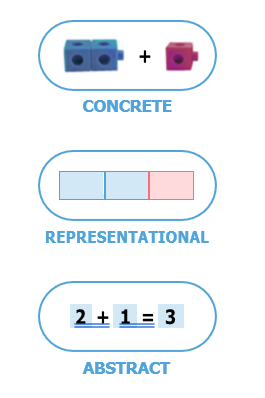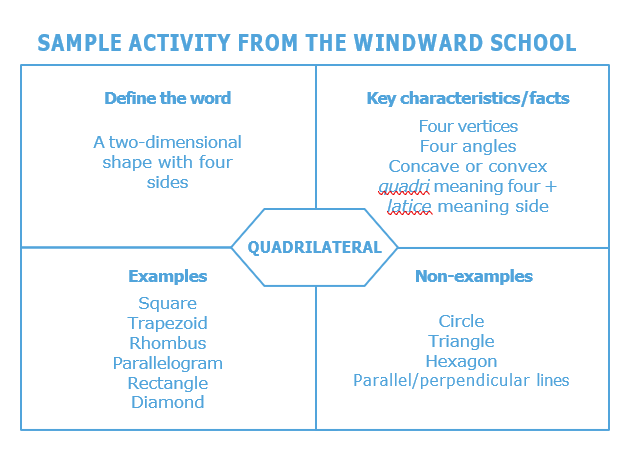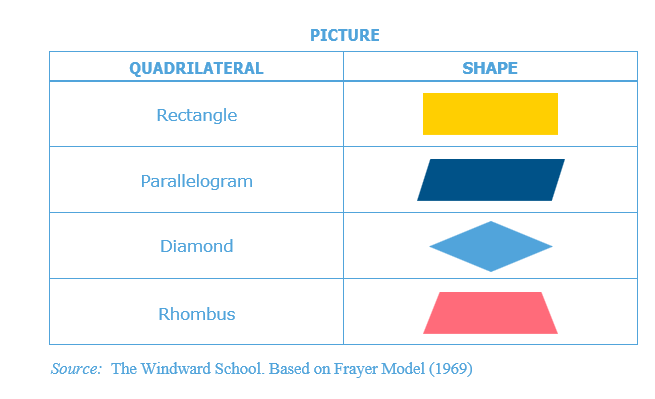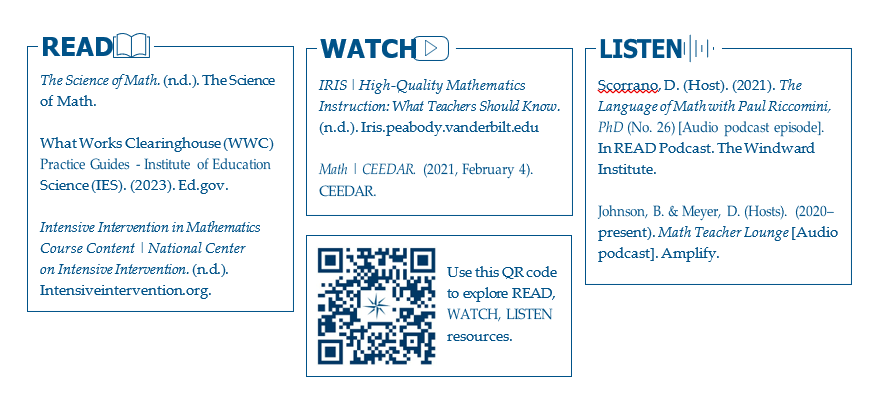Dyslexia, a neurobiological condition that affects reading and language processing, is widely recognized for its challenges related to reading and writing. However, its impact on mathematical abilities is often overlooked, even though dyslexia and other language-based learning disabilities can significantly impact mathematical learning and performance. Approximately 40% of children with reading difficulties have difficulties in learning math (Pedemonte et al., 2024). While dyslexia may not directly impair mathematical reasoning, it can influence various skills that are critical for math learning. This article explores the intersection of dyslexia and math, examining how dyslexia and other language processing disabilities can impact mathematical abilities and how educators—and parents—can support students who experience these challenges.
THE LANGUAGE OF MATH AND COGNITIVE DEMANDS
Math is a language in and of itself, with its own unique symbols and specialized vocabulary. One of the main ways dyslexia can impact math learning is through language processing difficulties. For students with dyslexia, understanding and interpreting mathematical language can be as challenging as reading and comprehending written text. Mathematical vocabulary terms like greater than, less than, and equal to—to name just a few—may be confusing, and students might struggle with word problems that require them to extract mathematical information from written text. In addition to language processing, many students with dyslexia and other language-based learning disabilities present with low working memory, which plays a crucial role in mathematics (DeSmedt et al., 2009). Moreover, deficits in mathematics are linked to poor working memory (Bull et al.,1999). The National Institutes of Health (NIH) defines working memory as “the small amount of information that can be held in an especially accessible state and used in cognitive tasks” (2014, p. 1). Put simply, working memory involves the ability to hold and manipulate information in one’s mind over short periods. This skill is essential for performing calculations and following multi-step procedures. As noted above, students with dyslexia often have weaker working memory capacities (Gray et al., 2019), making it difficult for them to keep track of numbers, remember steps in a problem, or retain information while solving complex equations.
Working memory challenges can also impact the ability to retrieve math facts automatically. Many students with dyslexia struggle with memorizing and recalling basic math facts, such as multiplication tables or addition and subtraction facts. This is often due to weaker working memory coupled with decreased processing speed. This lack of automaticity with math facts can slow down problem solving and make it more challenging for students to progress to more complex mathematical concepts. The time and effort required to recall these facts can also lead to increased cognitive load, making it harder for students to focus on higher-level problem-solving tasks.
Visual-spatial skills are another area where dyslexia can intersect with math (Helland & Asbjornsen, 2010). Visual-spatial weaknesses can impact the ability to recognize and interpret spatial relationships between objects, which is crucial for geometry, graph interpretation, and understanding mathematical patterns. Students with dyslexia may find it challenging to visualize shapes, understand symmetry, or comprehend spatial transformations. These difficulties can lead to student frustration and a lack of confidence in mathematical abilities.
IMPLICATIONS FOR TEACHING
Use Multiple Representations
To support students with dyslexia in math, educators need to adopt strategies that address the specific challenges outlined above. One effective approach is to provide multisensory instruction, which engages multiple senses to reinforce learning. For example, using manipulatives, visual aids, and hands- on activities help students to understand abstract mathematical concepts more concretely. By incorporating tactile and kinesthetic experiences, educators can make math more accessible and engaging for students with dyslexia and other language-based learning disabilities.
The concrete, representation/pictorial, abstract (CRA or CPA) approach to teaching mathematical concepts is an effective methodology that bridges students’ integration of more efficient algorithms as they build their conceptual knowledge throughout their mathematical development, from the earliest grades all the way up through secondary school and beyond (Powell et al., 2024).
Be Systematic and Explicit

Explicit and systematic instruction is another key strategy for supporting students with dyslexia in math. Educators should provide clear, step-by-step explanations of mathematical concepts and procedures, breaking them down into manageable parts. Repetition and practice are essential to reinforce learning and build automaticity. Additionally, using graphic organizers, visual models, and diagrams can help students organize information and understand the relationships between different mathematical elements. Systematic instruction requires that teachers have a deep knowledge of the progression of skills needed for math learning. These math skill progressions emphasize the importance of building foundational skills over time and that acquisition of foundational math skills is necessary for students to understand more complex mathematical concepts.


Technology can also play a vital role in supporting students. Tools such as text-to-speech software, speech- to-text applications, and digital math manipulatives can provide alternative ways for students with dyslexia to access and express mathematical ideas. These technologies can help bridge the gap between language and math, enabling students to focus on understanding concepts rather than struggling with language-related challenges.
| For a deeper dive into how technology can assist students with language-based learning disabilities, see “Leveraging Technology to Empower Students with Dyslexia” on page 49 of this issue. |
Focus on the Language of Mathematics and Its Real-World Application
Creating a supportive and inclusive classroom environment that focuses on the language of mathematics is crucial for students with dyslexia. Educators should encourage students to view challenges as opportunities for learning and growth. Explicit instruction of mathematics-specific vocabulary, emphasizing multiple-meaning math-specific terminology—using visuals and hands-on experiences—is essential. Providing positive reinforcement, celebrating successes, and prioritizing effort can boost students’ confidence and motivation. Additionally, allowing students to work at their own pace and providing opportunities for peer collaboration can create a sense of community and support within the classroom. Research indicates that math students should have multiple and varied opportunities to respond and engage in discourse in the math classroom (Powell et al., 2024). Students benefit from having to verbalize their own mathematical thinking. This also provides opportunities for teachers to monitor students’ understanding of mathematical concepts.
Focused instruction on word problems that are directly related to students’ real- world experiences makes mathematical thinking more relevant and, thus, more engaging. Solving real-world word problems requires multiple skills, including reading, understanding (both vocabulary and content), formulating a solution plan, identifying relevant information (and filtering out irrelevant information), performing the arithmetic, and checking for reasonableness. All these skills require a great deal of flexibility in thinking as students work to solve real-world mathematical problems.
It is important to note that linking mathematical operations (addition, subtraction, multiplication, division, etc.) to key words in word problems discourages mathematical reasoning. Instead, teachers should emphasize using an attack strategy and teach students to identify the schema of a word problem. An attack strategy is a series of steps that students use to guide their approach to solving word problems. Schemas are the underlying structures of math word problems. Six word-problem schemas are typically seen in word problems in elementary math curriculum and these six schemas fall into two distinct categories: additive (total, difference, change) and multiplicative (equal groups, comparison, combinations). Teachers should provide explicit instruction on each of these schemas and ample practice over time with all six types of schemas.
BUILD FACT AND COMPUTATIONAL FLUENCY
Fluency refers to doing math efficiently and accurately. Fact and computational fluency are not simply memorization tasks; mathematical fluency is built on a foundation of number sense, conceptual understanding, strategic and logical reasoning, and problem solving. Fluency frees up working memory to perform more complex, multi-step mathematical tasks. Many students with language- based learning disabilities, as noted earlier, have working memory challenges and will therefore likely need additional practice opportunities to develop the same level of mathematics proficiency as learners without working memory challenges.
Fluency development should be supported in the classroom by promoting the efficient use of strategies (e.g., counting on, compensation, building on known facts, etc.) and charting student progress. Explicitly teaching and promoting the efficient use of strategies, coupled with student charting of their own progress (including self- imposed goals over time) can be very motivating for students. Other research- validated approaches to building math fluency include incremental rehearsal (introducing facts in groupings based on known facts to unknown facts) and the “cover, copy, compare” approach, in which students look at a solved math fact, cover it, copy the problem and solve it, and then compare their work to the original problem (Cozad & Riccomini, 2016).
Supporting the development of fact and computational fluency requires both explicit instruction and consistent student practice over time. Practice with peers, connecting math fluency to mathematics in the home and real world, as well as fluency practice with technology and games, have also shown to be effective in building mathematical fluency for students.
Although individuals with dyslexia face unique challenges that can impact mathematical learning, they also frequently possess strengths in areas such as problem solving, critical thinking, logical reasoning, and creativity. By tapping into these strengths and providing appropriately scaffolded support, teachers and parents/guardians can help students with dyslexia develop a positive relationship with math.
Parents and guardians also play a crucial role in supporting their child’s math learning journey. Engaging in open communication with teachers and specialists, advocating for appropriate accommodations, and providing a supportive home environment can make a significant difference in a student’s mathematical success. Families can participate in math-related activities at home, such as playing math games, cooking, and measuring, which all reinforce math skills in real-life contexts.
By working collaboratively and proactively, educators, parents, and guardians can create a learning environment where students with dyslexia and other language-based learning disabilities can thrive and develop the mathematical skills they need for success in school and beyond. With the right support, students will develop confidence in their mathematical abilities and discover the joy and beauty of mathematics.
DID YOU KNOW?
As part of the brain’s executive function, working memory temporarily holds and manipulates information.
It is like a mental whiteboard.
People can hold only up to about 4 pieces of information in working memory at a time.
Information held in working memory will be lost in roughly
30 seconds if it is not reinforced.
Source: Centre for Applied Education Research. (2022).












